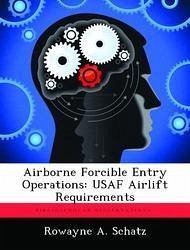Nicht lieferbar

Airborne Forcible Entry Operations: USAF Airlift Requirements
Versandkostenfrei!
Nicht lieferbar
As the United States transitions towards a national military strategy based on power projection instead of forward deployed armed forces, contingency forces and their capabilities will become increasingly more important. A key capability required to successfully implement a force projection defense strategy is the ability to conduct a forcible entry. In a forcible entry situation, either airborne or amphibious forces could secure a lodgment and prepare for the introduction of follow-on combat forces. This study investigates the requirements USAF airlift forces must meet to successfully support...
As the United States transitions towards a national military strategy based on power projection instead of forward deployed armed forces, contingency forces and their capabilities will become increasingly more important. A key capability required to successfully implement a force projection defense strategy is the ability to conduct a forcible entry. In a forcible entry situation, either airborne or amphibious forces could secure a lodgment and prepare for the introduction of follow-on combat forces. This study investigates the requirements USAF airlift forces must meet to successfully support airborne forcible entry operations. It reviews airlift contributions to past airborne operations in World War II, Grenada, and Panama. Then this study surveys the current world situation to determine what distances airlift forces must cover and the threat environments they must penetrate to successfully deliver airborne forces to potential target areas. Potential airborne forcible entry targets are developed by listing countries involved in armed conflict, drug trafficking, or state-sponsored terrorism, and removing littoral areas. This study then determines lift, distance, threat survivability, and training requirements for USAF airlift forces to successfully support airborne forcible entry operations. This work has been selected by scholars as being culturally important, and is part of the knowledge base of civilization as we know it. This work was reproduced from the original artifact, and remains as true to the original work as possible. Therefore, you will see the original copyright references, library stamps (as most of these works have been housed in our most important libraries around the world), and other notations in the work. This work is in the public domain in the United States of America, and possibly other nations. Within the United States, you may freely copy and distribute this work, as no entity (individual or corporate) has a copyright on the body of the work. As a reproduction of a historical artifact, this work may contain missing or blurred pages, poor pictures, errant marks, etc. Scholars believe, and we concur, that this work is important enough to be preserved, reproduced, and made generally available to the public. We appreciate your support of the preservation process, and thank you for being an important part of keeping this knowledge alive and relevant.










